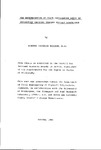THE DETERMINATION OF CRACK PROPAGATION RATES OF REFLECTION CRACKING THROUGH ASPHALT SURFACINGS
| dc.contributor.author | BROOKER, TIMOTHY NICHOLAS | |
| dc.contributor.other | School of Engineering, Computing and Mathematics | en_US |
| dc.date.accessioned | 2013-11-21T14:23:47Z | |
| dc.date.available | 2013-11-21T14:23:47Z | |
| dc.date.issued | 1986 | |
| dc.identifier | NOT AVAILABLE | en_US |
| dc.identifier.uri | http://hdl.handle.net/10026.1/2791 | |
| dc.description | Merged with duplicate record 10026.1/855 on 06.20.2017 by CS (TIS) | |
| dc.description.abstract |
A large proportion of the U.K. highway network constructed in the 1960's and 1970's contains lean concrete roadbase with bituminous surfacing. Pavements containing relatively high strength lean concrete have rarely required structural maintenance (thick overlay or reconstruction) but have required maintenance because of reflection cracking where the surfacing cracks above cracks in the lean concrete. The time of appearance of this cracking is very variable (2-20 years). Field observations indicate that roadbase transverse crack spacings are often greater than 5m. Reflection cracking at these long spacings can be caused by thermal stresses. This project identifies conditions under which thermal reflection cracking will occur and develops a predictive model that allows estimation of the combined effect of thermal and traffic stresses. Finite element analyses indicate that initial crack development is likely to be caused by thermal stresses and final cracking will be assisted by traffic stresses. A temperature model has been developed to determine roadbase daily temperature range and surfacing temperature on a mean monthly basis. Thermal reflection cracking is considered to result from daily cycle fatigue rather than an extreme low temperature mechanism. A test rig has been developed to apply cyclic crack opening movements and simulative tests have been accelerated to 0.1Hz by using a "bitumen stiffness", fatigue criterion. Finite element results, displacements recorded during tests and tensile creep tests to determine mix stiffness, enable dc/dN and K1 values and material constants (A, n) to be determined. This fracture mechanics interpretation of test results serves as the basis of the predictive model for thermal reflection cracking that is consistent with observations from an untrafficked road. The combined estimate of thermal and traffic stresses cannot however explain reflection cracking at <5m spacings. This cracking apparently initiates at the surface and is probably influenced by other mechanisms. | en_US |
| dc.description.sponsorship | University of Birmingham, the Transport and Road Research Laboratory (TRRL), U.K. and Devon and Cornwall County Council Highways Departments | en_US |
| dc.language.iso | en | en_US |
| dc.publisher | University of Plymouth | en_US |
| dc.title | THE DETERMINATION OF CRACK PROPAGATION RATES OF REFLECTION CRACKING THROUGH ASPHALT SURFACINGS | en_US |
| dc.type | Thesis | |
| plymouth.version | Full version | en_US |
| dc.identifier.doi | http://dx.doi.org/10.24382/3889 | |
| dc.identifier.doi | http://dx.doi.org/10.24382/3889 |
Files in this item
This item appears in the following Collection(s)
-
01 Research Theses Main Collection
Research Theses Main


